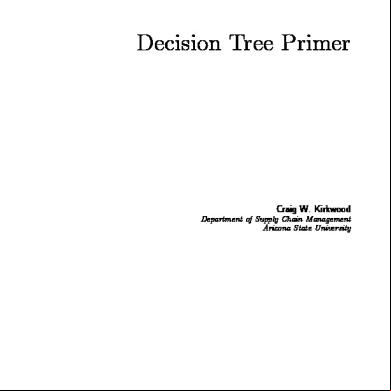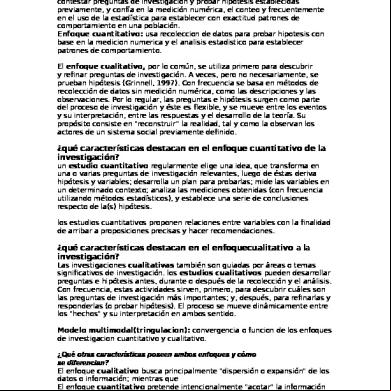Surgical Wound Classification Decision Tree 28w3b
This document was ed by and they confirmed that they have the permission to share it. If you are author or own the copyright of this book, please report to us by using this report form. Report l4457
Overview 6h3y3j
& View Surgical Wound Classification Decision Tree as PDF for free.
More details h6z72
- Words: 398
- Pages: 1
Surgical Wound Classification Decision Tree Is Is there there a a wound? wound?
NO NO
No No Wound Wound Classification Classification
YES YES
Class Class II Clean Clean
YES YES
Class Class IIII Clean Clean -Contaminated Contaminated
YES YES
Class Class III III Contaminated Contaminated
YES YES
Class Class IV IV Dirty, Infected Dirty, Infected
YES YES IsIsthe thewound wound • clean • clean(ie, (ie,not notinfected infectedor orinflamed) inflamed);oror • the result of a non-penetrating, blunt trauma? • did the incision follow non-penetrating, blunt trauma? Was the procedure free from entry into the respiratory, alimentary, Was the procedure free from entry into respiratory, alimentary, or or genitourinary tract? genitourinary tract? Was Wasthe thewound woundprimarily primarilyclosed closedor ordrained drainedwith withclosed closeddrainage drainage (eg, bulb drain)? (eg, chest tubes)?
NO NO Was Wasthe therespiratory, respiratory,alimentary, alimentary,or orgenitourinary genitourinarytract tractentered enteredunder under controlled controlledconditions conditionswithout without • evidence • evidenceofofinfection infectionor orcontamination contamination;oror • major break in technique gastrointestinal tract)? • major break in technique(eg, (eg,spillage spillagefrom fromthe gastrointestinal tract)?
NO NO IsIsthe thewound wound • fresh, • fresh,open, open,or oraccidental; accidental;or or • is gastrointestinal tract; or • isthere theregross gross(ie, (ie,visible) visible)spillage spillagefrom fromthe GI tract; or • is • isthere therenon-purulent non-purulentinflammation inflammationpresent? present? Was technique (eg, unsterile instruments Wasthere thereaamajor majorbreak breakininsterile technique (eg, unsterile instruments used) used) during the procedure? during the procedure?
NO NO IsIsthis thisan anold oldwound wound(ie, (ie,greater greaterthan than44toto66hours) hours)with with • retained devitalized tissue (eg, gangrene, • retained devitalized tissue (eg, gangrene,necrosis), necrosis);oror • existing • existingclinical clinicalinfection infection(eg, (eg,purulence), purulence);oror • perforated viscera? • perforated viscera? REFERENCES 1. Mangram AJ, Horan TC, Pearson ML; Hospital Infection Control Practices Advisory Committee. Guidelines for prevention of surgical site infection, 1999. Am J Infect Control. 1999;27(2):97-132. 2. Garner, JS. CDC guideline for prevention of surgical wound infections, 1985. Supercedes guideline for prevention of surgical wound infections published in 1982. (Originally published in 1985). Revised. Infect Control. 1986;7(3):193-200. http://wonder.cdc.gov/wonder/prevguid/p0000420/p0000420.asp. Accessed July 31, 2011. 3. Altemeier WA. Surgical infections: incisional wounds. In: Bennett JV, Brachman PS, eds. Hospital Infections. Boston, MA: Little, Brown and Co; 1979:287-306. 4. Howard JM, Barker WF, Culbertson WR, et al. Postoperative wound infections: the influence of ultraviolet irradiation of the operating room and various other factors. Ann Surg. 1964;160(Suppl2):1-192. NOTE: These are the original source documents for development of the CDC surgical wound classification system.
Copyright © AORN, Inc., 2011
NO NO
No No Wound Wound Classification Classification
YES YES
Class Class II Clean Clean
YES YES
Class Class IIII Clean Clean -Contaminated Contaminated
YES YES
Class Class III III Contaminated Contaminated
YES YES
Class Class IV IV Dirty, Infected Dirty, Infected
YES YES IsIsthe thewound wound • clean • clean(ie, (ie,not notinfected infectedor orinflamed) inflamed);oror • the result of a non-penetrating, blunt trauma? • did the incision follow non-penetrating, blunt trauma? Was the procedure free from entry into the respiratory, alimentary, Was the procedure free from entry into respiratory, alimentary, or or genitourinary tract? genitourinary tract? Was Wasthe thewound woundprimarily primarilyclosed closedor ordrained drainedwith withclosed closeddrainage drainage (eg, bulb drain)? (eg, chest tubes)?
NO NO Was Wasthe therespiratory, respiratory,alimentary, alimentary,or orgenitourinary genitourinarytract tractentered enteredunder under controlled controlledconditions conditionswithout without • evidence • evidenceofofinfection infectionor orcontamination contamination;oror • major break in technique gastrointestinal tract)? • major break in technique(eg, (eg,spillage spillagefrom fromthe gastrointestinal tract)?
NO NO IsIsthe thewound wound • fresh, • fresh,open, open,or oraccidental; accidental;or or • is gastrointestinal tract; or • isthere theregross gross(ie, (ie,visible) visible)spillage spillagefrom fromthe GI tract; or • is • isthere therenon-purulent non-purulentinflammation inflammationpresent? present? Was technique (eg, unsterile instruments Wasthere thereaamajor majorbreak breakininsterile technique (eg, unsterile instruments used) used) during the procedure? during the procedure?
NO NO IsIsthis thisan anold oldwound wound(ie, (ie,greater greaterthan than44toto66hours) hours)with with • retained devitalized tissue (eg, gangrene, • retained devitalized tissue (eg, gangrene,necrosis), necrosis);oror • existing • existingclinical clinicalinfection infection(eg, (eg,purulence), purulence);oror • perforated viscera? • perforated viscera? REFERENCES 1. Mangram AJ, Horan TC, Pearson ML; Hospital Infection Control Practices Advisory Committee. Guidelines for prevention of surgical site infection, 1999. Am J Infect Control. 1999;27(2):97-132. 2. Garner, JS. CDC guideline for prevention of surgical wound infections, 1985. Supercedes guideline for prevention of surgical wound infections published in 1982. (Originally published in 1985). Revised. Infect Control. 1986;7(3):193-200. http://wonder.cdc.gov/wonder/prevguid/p0000420/p0000420.asp. Accessed July 31, 2011. 3. Altemeier WA. Surgical infections: incisional wounds. In: Bennett JV, Brachman PS, eds. Hospital Infections. Boston, MA: Little, Brown and Co; 1979:287-306. 4. Howard JM, Barker WF, Culbertson WR, et al. Postoperative wound infections: the influence of ultraviolet irradiation of the operating room and various other factors. Ann Surg. 1964;160(Suppl2):1-192. NOTE: These are the original source documents for development of the CDC surgical wound classification system.
Copyright © AORN, Inc., 2011










